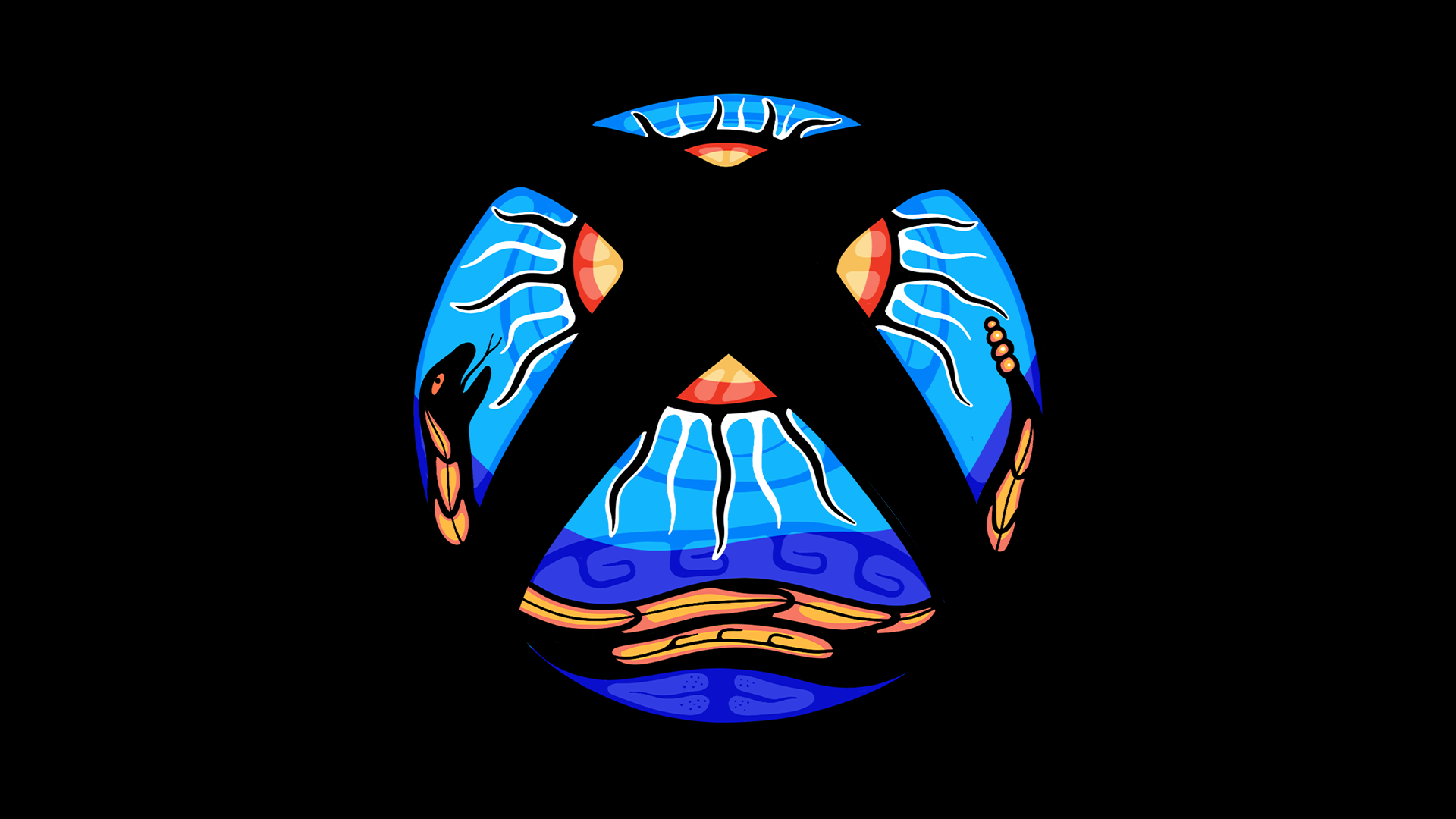
Xbox Celebrates Indigenous Peoples of the World
For much of my life, I attempted to cover my Karuk heritage. I would hear a hurtful stereotype but not have the courage to speak up because previous instances were met with, “but you’re white,” as if my Indigenous heritage should be splayed along my skin to count. Fast forward to the summer of 2019 when I took the opportunity to celebrate my birthday with my tribe at our annual reunion on the Klamath River. I had conversations with members of my tribe who expressed that they could not imagine themselves working in the tech industry or that it had a place for them. As a person with Indigenous heritage and a leader in the gaming industry, those conversations sparked a passion to overtly represent Indigenous people through my work. Today, as Xbox celebrates International Day of the World’s Indigenous Peoples, I am writing from the ancestral homeland of the Congaree and the Tsalaguwetiyi (Cherokee, East) Peoples and I commit to telling the importance of representation of Indigenous Peoples in their honor.
My tribe, the Karuk, are the “Upriver People.” We have been the stewards of our Northern California territories since time immemorial. To this day, our Department of Natural Resources practices Indigenous land management and cultural burning where permitted while advocating for our lands. In my home office, I display a traditional dentalium shell necklace being worn by Sheepsquatch on my bookcase. I also have on my office bookshelf a copy of “Fire Race: A Karuk Coyote Tale of How Fire Came to the People” by Johnathan London. These links to my heritage are proudly on display during every conversation I have at Xbox and have led to great conversations about Indigenous representation with colleagues. I also serve as the co-lead for our Indigenous employee community group at Xbox.
For those who don’t work in the tech industry, there is often a misconception that you have to know how to code to get into gaming. But games are about so much more than just code; video games are an artistic medium told through visual art, music, and narrative storytelling. Indigenous peoples have traditionally ingrained wisdom and knowledge through oral narrative, through passing stories and songs down from one generation to the next. Now, these stories can continue to be memorialized through video games by those of us who work in the industry or those who will tell our stories.
I distinctly remember playing Never Alone, which is a puzzle platformer developed in collaboration with the Iñupiat Alaskan Native people. The rich narrative tells the story of a young Iñupiat girl and an arctic fox who are surviving the Arctic tundra, which has been ravaged by an everlasting blizzard. As I progressed through the story, I was able to unlock fascinating cultural highlights which are actual interviews from Iñupiat members who share about their beliefs and culture. I soaked in the stories about how the northern lights came to be or the importance of caribou leather insulating from the cold. I finished the game on a Wednesday and found myself on a flight to Alaska on Saturday morning. I admired an elderly woman and her daughter, who was wearing traditional clothing, her fur lined hood on a royal blue parka, boarding the plane from Anchorage to Fairbanks. To my excitement, their seats were next to mine on the plane. She asked why I was visiting Alaska. With a kind smile, she nodded and listened as I rambled excitedly about this video game, this Indigenous artistic masterpiece, and that I was coming to Alaska to visit in real life what I had experienced through the game. When I’d finished, the elderly woman revealed that she was an Iñupiat elder and one of the tribal members who contributed to the game’s creation. In that moment I truly felt not alone – seen, understood by, and connected for just a moment with another Indigenous person thousands of miles from my own home.
I know what it’s like to feel alone. So many Indigenous people cover who they are for fear of being misunderstood or made fun of. I can’t tell you how many people have asked me why I don’t wear a feather headdress, or worse, how many people are surprised to learn that Indigenous peoples are alive and well, not just a relic from history. Indigenous peoples are underrepresented in every area of life. Through video games, we at Xbox have the incredible opportunity to elevate and give voice to communities that have been systemically oppressed. All people deserve a place at the table. I love this industry and I love video games as an artistic, narrative medium.
Join Xbox as we celebrate the rich histories of Indigenous peoples all over the world for International Day of the World’s Indigenous Peoples as well as throughout the year:
Give
Gaming and Impact with Microsoft Rewards
Throughout the month of August, we’re adding organizations that support Indigenous communities to Microsoft Rewards on console. Microsoft Rewards members in the United States and the Canada can earn and donate points to organizations supporting gaming and disability communities with Xbox.
- American Indian Science and Engineering Society: AISES is a national nonprofit organization focused on substantially increasing the representation of Indigenous peoples of North America and the Pacific Islands in science, technology, engineering, and math (STEM) studies and careers.
- First Nations Development Institute: Our mission is to strengthen American Indian economies to support healthy Native communities. We invest in and create innovative institutions and models that strengthen asset control and support economic development for American Indian people and their communities.
- Indspire: Indspire is an Indigenous national charity that invests in the education of First Nations, Inuit, and Métis people for the long-term benefit of these individuals, their families and communities, and Canada. In partnership with Indigenous, private and public sector stakeholders, Indspire educates, connects and invests in Indigenous people so they will achieve their highest potential.
Xbox gamers can earn Microsoft Rewards points in various ways, such as playing or purchasing games after downloading the Microsoft Rewards app on Xbox. Earn points and redeem them for real rewards. Join us today and donate through Xbox.
Discover
Visual Storytelling through Indigenous Artists and Xbox
Representation is important. We say this throughout the year for all underrepresented communities, but it’s particularly important for the Indigenous community. Each tribe has a unique style to their artwork as well as medium (e.g. basketry). We worked with Indigenous artists across the world to redesign the Xbox logo in a way that was authentic to them and their tribes. Xbox will be updating this page with more art throughout the month, so stay tuned! Each piece tells its own story, so read on to learn about these amazing artists and the stories they tell through art:
Artist: Chief Lady Bird
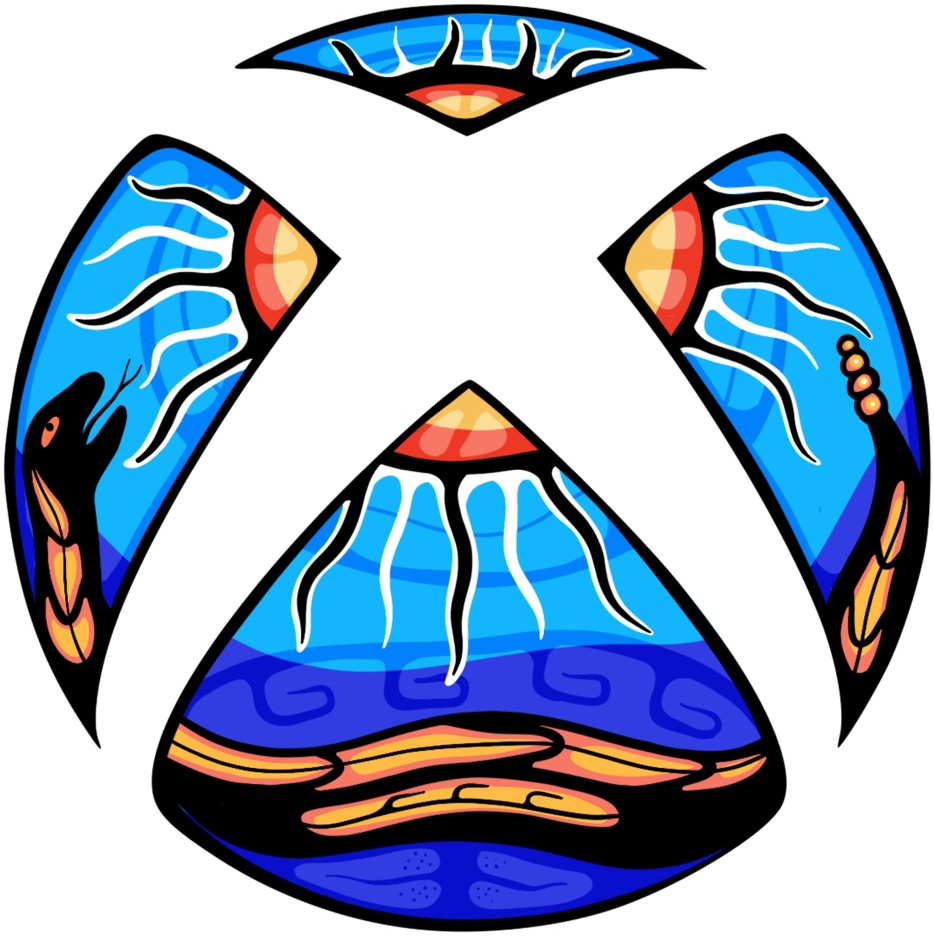
Chief Lady Bird: When approaching this logo, I was inspired by the connection between video games and Anishinaabe oral tradition, which is storytelling and the use of narrative to experience the world around us. In this drawing in particular, I was imagining a video game in woodland style, and was curious about which cultural icons or creatures would be cast as a “boss” in an RPG. I opted for a snake in this instance as opposed to one of our sacred spirits because it has been used as a symbol cross-culturally and across the globe in many different ways; I felt like it could be widely understood even when presented through an Anishinaabe lens. – Instagram: @chiefladybird
Artist: Carl Avery
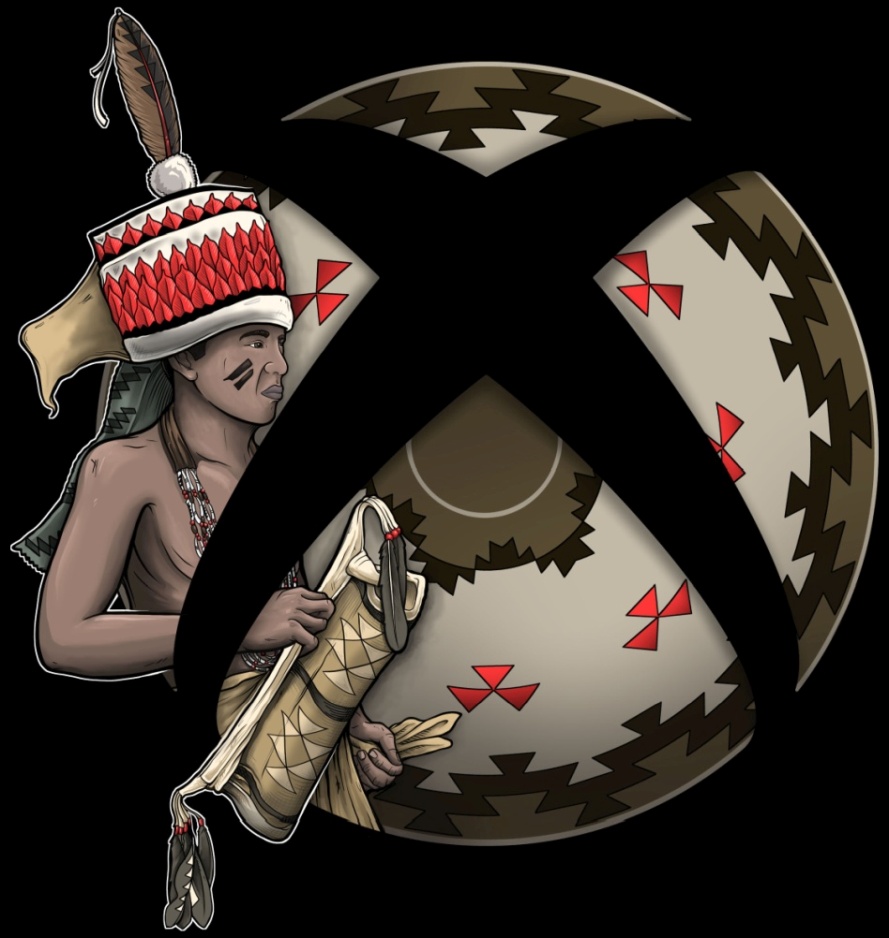
Carl Avery: The Xbox logo I created is inspired by the traditional regalia worn during the Jump Dance of the Yurok people. This dance is meant to bring healing and positive energy to the earth as well as promote healthy crops, healthy rivers, and plentiful harvest. The headdress is made from woodpecker scalps, rabbit fur, and deer hide. This headdress is usually dressed up with some abalone and other shells as the Yurok Tribe lived along the Klamath River extending into the mouth of the river where it meets the Pacific Ocean. The headdress feather is that of the American Bald Eagle dressed with abalone using the Sturgeon Back design. The necklace is made from dentalium shells and is used traditionally for trade and currency. The basket is made from willow sticks, woven to hold medicine during the dance. The jump dance lasts ten days in total and is performed every two years by a chosen family, which is mostly determined based on the location of the dance site and a family’s land. In the background of this image is a basket also made from willow sticks, which can be found along the riverbanks. The designs are also all specific to the area. Starting in the middle is the Swallow Tail design, followed by the snake nose design, and finally the friendship design border. The different colors in the design were often dyed using roots, berries, and other natural dyes. Red, being the rarest, was highly sought after and was held for the tribes’ most important members. This artwork is loosely based on my family’s regalia in the dance grounds in Pecwan, CA. – Website: Carl Avery Studios
Artist: Bethany Fackrell
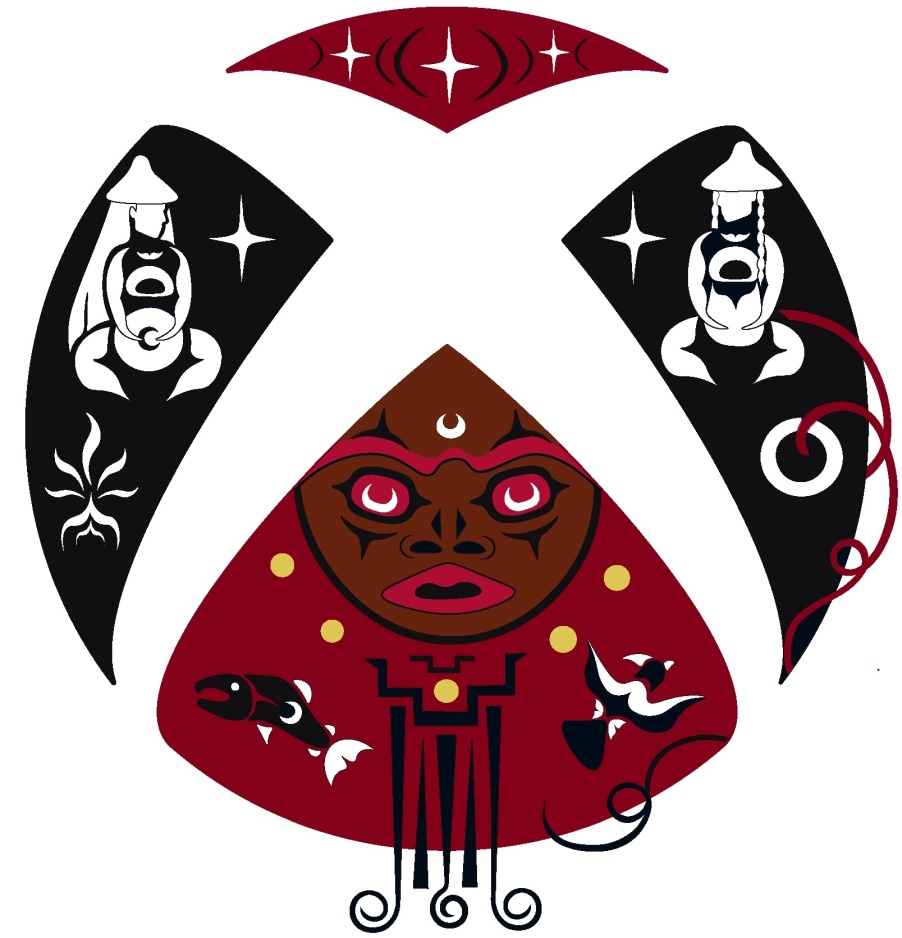
Bethany Fackrell: In re-designing the Xbox logo, I am honored to represent my people, the Snoqualmie Tribe, while sharing what makes us culturally different in a contemporary and traditional art form. Using the traditional “make-ups” of a story board, I chose to tell the story of our peoples’ creation.
Story Boards are a traditional art style used by the Snoqualmie people, unlike the commonly known totem poles by many of Salish Tribes. Story Boards were used to tell important or spiritual stories by using symbolic references and purposeful representation in the maker’s story. Traditionally, this art is carved into cedar and is simplistic consisting of pigments of black, red, white, and sometimes yellow.
When Two sisters go digging for fern roots, they end up in Sky World and get married to stars. One of the sisters becomes pregnant. Then one day, the sisters go to dig fern roots in Sky World and dig deep enough to make a hole and see earth. The sisters decided to weave a cedar rope long enough to get back home with the child. When they arrived, they celebrated their return home, during which Dog Salmon stole the child away. Blue Jay, who found the child, (much older now) returned him home. Upon their return it was discovered he had powers and was too strong to stay on Earth. So, he returned to the Sky World and became the moon; also known as “Transformer” (creator).
At the top of the logo is the Sky World. There are also two large stars on the left and right of the logo by each sister, representing their marriage to the stars. The cedar rope represents how the sisters returned back to Earth. Throughout the logo you see (what I believe) represents the most important aspects of our creation story. I used crescent moons inside the pregnant sister and in Dog Salmon to represent the child’s journey in becoming the moon. On the bottom of the logo is a large red moon, being the final transition and form of the child/ young adult (as our creator). I included Dog Salmon and Blue Jay in this section, for their significance in the events of how the child becomes the moon, thus creating us. The waterfall and the five circles represent our tribe and the five clans. – Website: Bethany Fackrell
Artist: Rubii Red
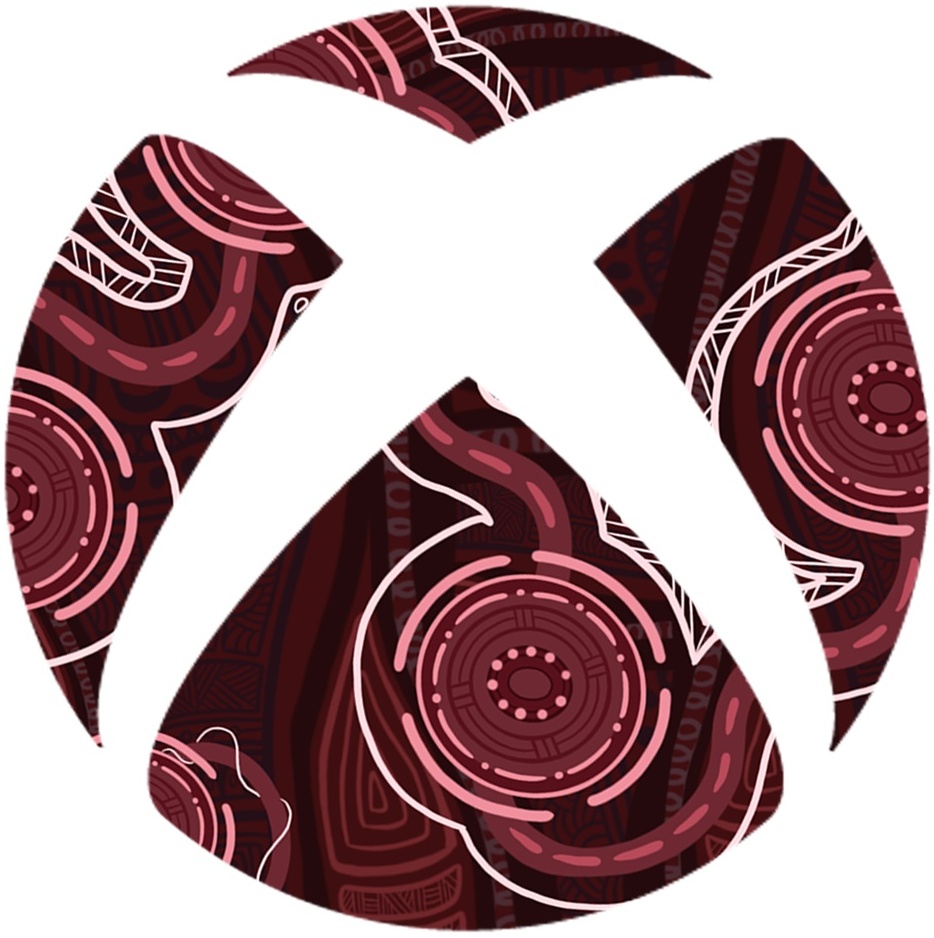
Rubii Red: The work is my interpretation of connection, community and journey. A lot of my work reflects those themes, because as a First Nations woman, they are important to me and have helped shape me into the person I am today. I’m on a journey, learning about who I am by connecting to the community and learning more about my culture from my Elders. – Website: Rubii Red Art
Artist: Haimona Maruera and Dillon King
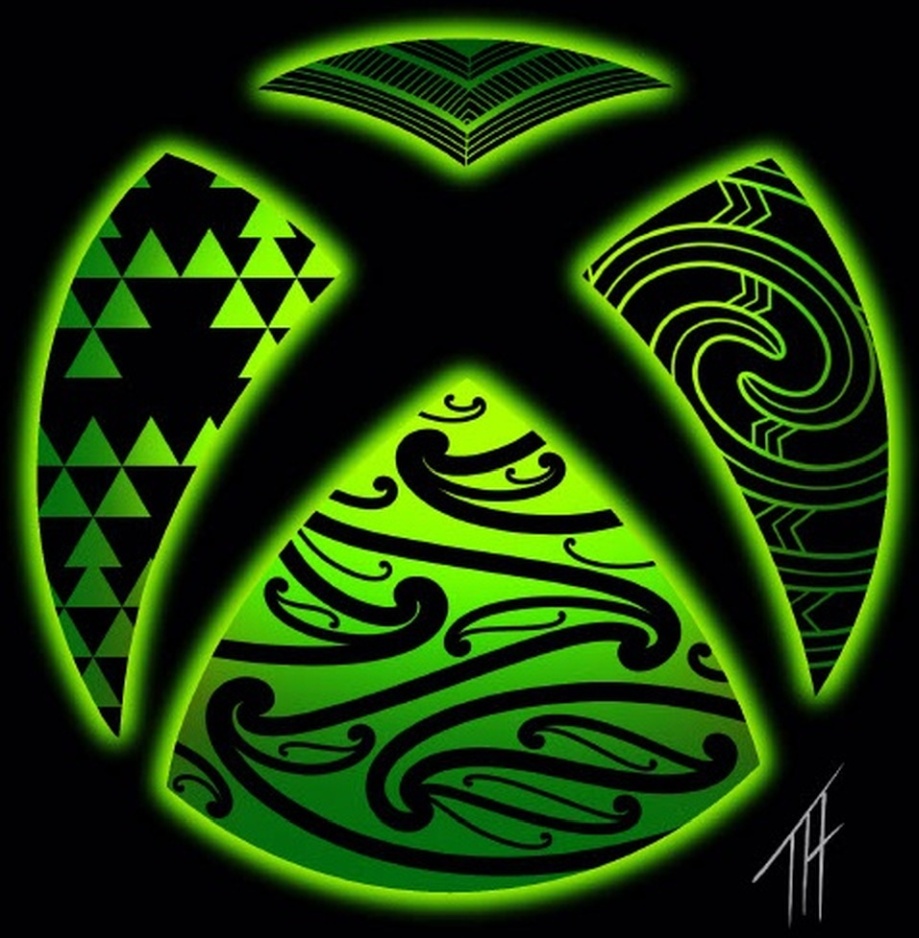
Haimona Mauera (cultural advisor) and Dillon King: As proud descendants of Ngāti Ruanui, Te Āti Haunui-ā-Pāpārangi, Tūwharetoa, Ngāti Kahungunu ki Heretaunga and Ngāti Kahungunu ki Te Wairoa, this design derives from the Māori atua (god) named Māui. Māui was the infamous atua known by several names such as Māui- Pōtiki (the last born), Māui-Tinihanga (the mischief), Māui-Tikitiki-a-Taranga (the topknot o Taranga), and Māui-te-whare-kino (the house of trouble). This infamous atua brought the inquisitive and the intellectual attributes to our world. This Xbox logo represents the key art functions of Te Ao Māori, which we practice as guardians of our culture and identity. The left section represents Raranga (weaving) which is used to make food baskets, cloaks, and bassinets. The bottom section represents Ko`whaiwhai (pattern) which is commonly seen in our wharenui (meeting houses) and represents the many generations of Māori. The right section represents Whakairo (traditional carving) which is used in our wharenui (meeting houses) and on weaponry. Finally, the top section represents Tā Moko (skin markings) which allows myself as an Indigenous Māori to display genealogy and history through the etching, piercing, and pigmenting of skin.
Bethesda Celebrates Sámi National Day
Author: Anna Erlandsson, Community Manager at Bethesda Nordics
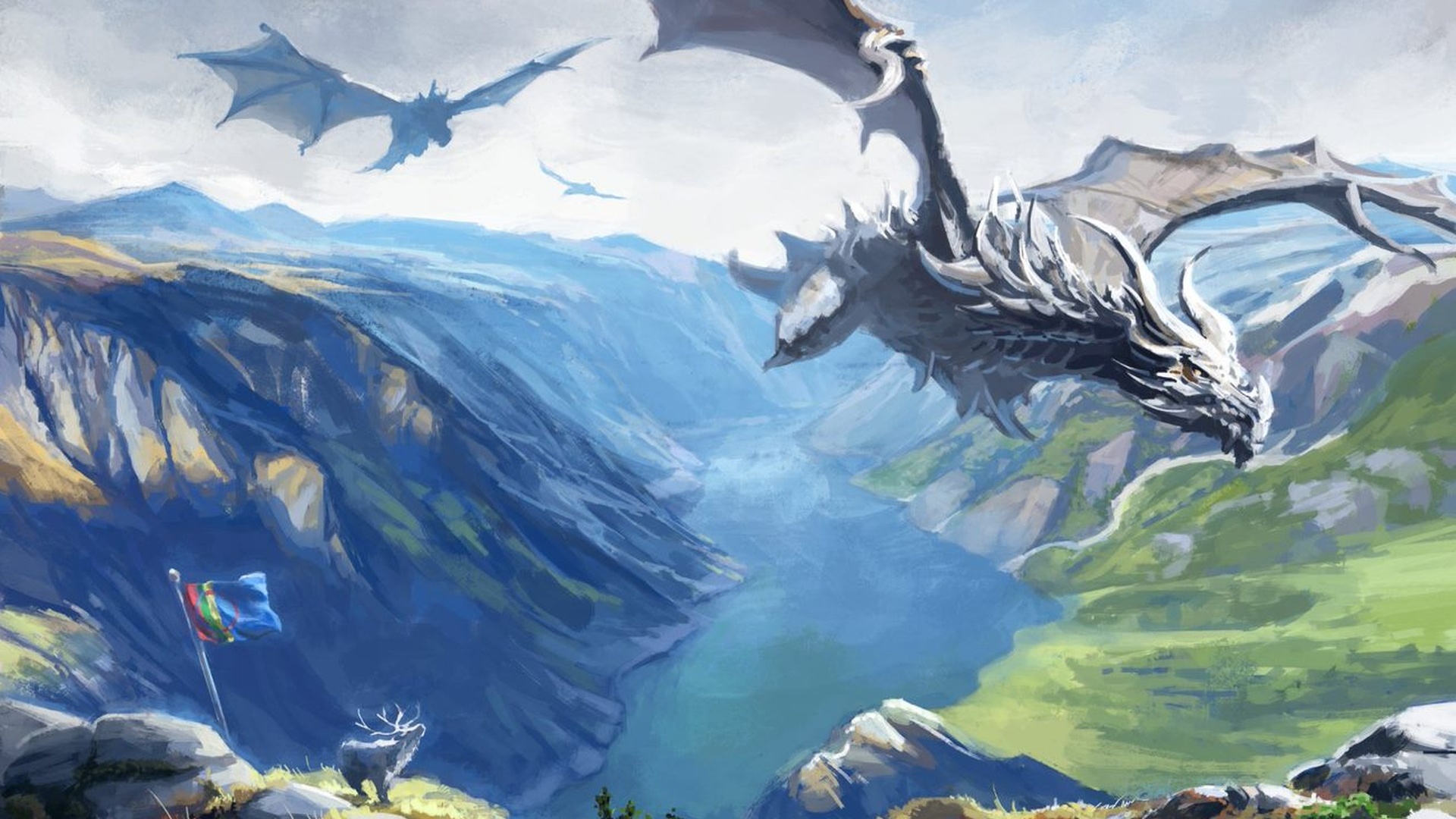
The Sámi people are one of the Nordics indigenous groups that lives in both Norway, Sweden, Finland and Russia. Throughout the history, the Sámi people, as many Indigenous groups, have been subjects for discrimination and injustice. With that in mind and with the rich history and impact the Sámi people have on the Nordics, I feel that it is important to celebrate the Sámi National Day, just as we do with the other national days of the Nordics.
To better highlight the day, I decided to work with Swedish artist Petra Brandström to have her make an artwork that captured the proudness and freedom of the Sámi people combined with Bethesda elements.
“It was really fun to be able to do this. I love Skyrim, dragons, and the beautiful landscapes we have in the Nordics and I am very proud to have been part of highlighting the Sámi national holiday.”
In addition to this and to give Nordics with a Sámi heritage a voice and space on this special day, I worked with Norwegian and Sámi ESO streamer Vikingtrash who made a stream where she talked about the Sámi culture and played ESO.
“It felt so special and important to celebrate the day of all Sámi people, while also educating about the history and traditions we have. I, myself, have been trying to represent my Sámi heritage more and I’m so happy to share it with everyone. I think it’s great that we can have indigenous culture in the spotlight and show everyone the beautiful culture that the Sámi people have.”
For the Nordics and for our community, it is important to highlight the Sámi National Day since the Sámi people are part of the Nordic history, their heritage and culture have had a huge impact on the countries here and they are a living culture and part of the future here. It is something we must remember and keep alive.
Xbox Ambassadors Feature Stories about Indigenous Representation in Gaming

On International Day of the World’s Indigenous Peoples and the following days, we will be spotlighting stories about representation in gaming from Indigenous gamers in the Xbox Ambassadors community. Read their stories here.
Play
Explore Games Curated by Indigenous Communities at Microsoft

Last November, we partnered with Indigenous communities at Microsoft to highlight games, inspired by Indigenous creators, culture, and protagonists around the world on Xbox and Windows. This collection is available year-round as part of our ongoing work to create more inclusive gaming ecosystems and elevate content that resonates with communities while increasing awareness of their unique perspectives and artistry.
A few highlights from the full Xbox games and Windows games collections spanning Indigenous creators, playable characters, and titles inspired by Indigenous culture include:
Tell Me Why (Available on Xbox Game Pass and Rated M) – Set in rural Alaska, this game features Indigenous characters. The development team worked closely with Huna Tlingit community leaders and the Huna Heritage Foundation to represent Tlingit culture. This game includes strong LGBTQIA+ themes and features, Michael, an Indigenous queer character.
Raji: An Ancient Epic – Play as Raji, a young girl in search of her brother, during a war between gods and demons. This unique action-adventure game set in ancient India is inspired by Hindu and Balinese mythology.
Never Alone – Alaska Native storytellers helped to develop this game around traditional Iñupiat lore. Never Alone features an Iñupiaq girl named Nuna and her Arctic fox companion. Players experience the narrative through a series of atmospheric puzzles, symbolizing the intergenerational transference of wisdom through collecting “cultural insights” across the harsh arctic environment. Learn more about the making of the game here.
Button City – This colorful narrative game was created by Shandiin Yazzie Woodward, an artist who identifies as Diné. Button City focuses on the true power of friendship and importance of community building. Subliminal Games is dedicated to lifting diverse and marginalized voices within games and is Indigenous owned.
View the collections on the Microsoft Store on Xbox and the Microsoft Store on Windows in Argentina, Australia, Brazil, Canada, Chile, Colombia, Mexico, New Zealand, the United Kingdom, and the United States. Visitors can find Indigenous community picks at any time by searching within the Stores for “Indigenous” and related terms. Content is subject to availability by country.
Tune In

Xbox Plays will Feature Indigenous Streamers
In celebration of International Day of the World’s Indigenous People, Xbox Plays will be spotlighting streamers and creators from the Indigenous community during the week of August 8th. Follow us on our Xbox Twitch Channel and don’t miss any of the action!
- Tuesday, August 9 at 9:30 a.m. (PDT) – Chief Sweet
- Wednesday, August 10 at 9:30 a.m. (PDT) – BloodieKnux
- Thursday, August 11 at 9:30 a.m. (PDT) – Gunade
- Thursday, August 11 at 3:30 p.m. (PDT) – Cuzb0T
- Friday, August 12 at 9:30 a.m. (PDT) – Hiosik
Xbox Honors International Day of the World’s Indigenous Peoples with New Gamerpic, Profile Themes, and Avatar Items!

In partnership with the Indigenous artists we worked with to bring you custom Xbox spheres, we’re introducing new gamerpics, profile themes, and avatar items throughout the month of August! The gamerpic and profile theme will be available on console and the Xbox PC app. Get your avatar items here.
Learn more about all that Xbox is doing to engage our communities at the Xbox Community Hub.
